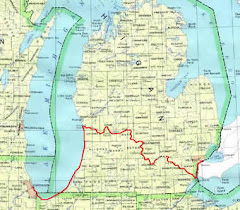
In September 1940 I became a member of the pledge class of the Beta Theta Pi fraternity at the Colorado School of Mines* along with seven other freshmen from Illinois, Mississippi, and Oklahoma, and various towns in Colorado. We were given the duty on the night before the Colorado College football game to guard the "M," a large lighted stone assemblage high on the side of Mount Zion in the front range of the Rockies (above Golden) that could be seen for many, many miles out towards Denver and the prairies. We were given a pack of fused dynamite to use as a signal to alert the campus below if any Colorado College vandals showed up.
It was a long trudge up the mountain to the darkened "M" that night, but we were honored and alert. A road block at the bottom of the mountain intended to deter any invaders was manned by other Miners so we confidently settled in, not expecting any action. Then over the other side of the mountain from the direction of Buffalo Bill's grave on Lookout Mountain came several automobiles with their lights out. CC Invaders!
We were obviously outnumbered but we ran around in the dark, throwing stones and shouting hoping that the CC guys would think there were many of us. I was in charge of the dynamite so I lit the fuse and threw the pack over the side of the mountain. It exploded with a glorious "BANG" that rang across the entire valley below.
The CC guys were obviously startled and spooked and jumped in their cars and roared down the mountain. I learned that most of them avoided the roadblock but one carload was captured. They were treated to an application of fast-evaporating carbon tetra-chloride to their privates, had their heads shaved and an "M" drawn on their bare scalps with hair-growth inhibiting silver nitrate.
I don't suppose that kind of activity would be tolerated these days.
At least one of the unsuccessful Colorado College vandals who got captured and dosed with carbon-tet and silver nitrate was a good sport. At the following football game at Colorado Springs he was vending popcorn or peanuts or something in the stands on our side of the stadium. Some of our guys recognized him even though he was wearing a cap to hide his shaved dome. We all started yelling for him to take it off. With a smile and a laugh he doffed his cap and bent over to show the audience his heard with the "M" plain to see. The cheers and laughs were loud and gratifying.
The CC guys were obviously startled and spooked and jumped in their cars and roared down the mountain. I learned that most of them avoided the roadblock but one carload was captured. They were treated to an application of fast-evaporating carbon tetra-chloride to their privates, had their heads shaved and an "M" drawn on their bare scalps with hair-growth inhibiting silver nitrate.
I don't suppose that kind of activity would be tolerated these days.
At least one of the unsuccessful Colorado College vandals who got captured and dosed with carbon-tet and silver nitrate was a good sport. At the following football game at Colorado Springs he was vending popcorn or peanuts or something in the stands on our side of the stadium. Some of our guys recognized him even though he was wearing a cap to hide his shaved dome. We all started yelling for him to take it off. With a smile and a laugh he doffed his cap and bent over to show the audience his heard with the "M" plain to see. The cheers and laughs were loud and gratifying.
*Being a mining school with Army Engineer ROTC mandatory explosives were part of the curriculum. We didn't ring the school bell to awaken the campus, we would set off dynamite over the face of Castle Rock which would reflect the sound far and wide.
 |
| © Arthur Lakes Library |












